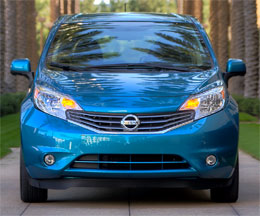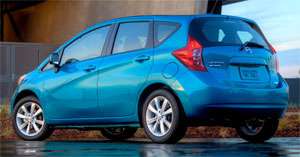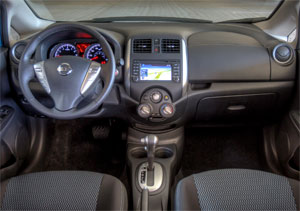The Nissan Versa has proven to be a popular subcompact with budget minded folks looking for roomy, economical, and highly reliable, if still quite basic transportation. That’s especially true of the most versatile hatchback body style. Now that 5-door Versa is not only all new but seeks to stand out from the Versa sedan by adding “Note” to its nameplate. As, let’s see if this “Note” strikes the right chord…
The 2014 Nissan Versa Note may be a new tune for Nissan, but it is still a Versa. So, it remains in the same entry-level genre as before, as it stays based on Nissan’s global “V” platform just like the Versa sedan.
Exterior length is actually less than the sedan however, at 163 inches due to its shorter overhangs, but wheelbase is the same at a long 102.4-inches. That translates into class leading rear leg room so you can take the band along when you hit the road.
 The Note does has a smoother body than the outgoing Versa hatchback, though we still wouldn’t call it handsome. But, this is a purposeful design that prioritizes space over beauty.
The Note does has a smoother body than the outgoing Versa hatchback, though we still wouldn’t call it handsome. But, this is a purposeful design that prioritizes space over beauty.
Though somewhat muted in our Alpine White edition, the softer styling allows the Note to accomplish two good things: be more aerodynamically efficient and bring a unique look to subcompacts. Nissan’s first application of active grille shutters and aero flares on the tail lights also serve the cause.
The engine is the same as the Versa Sedan, a 1.6-liter I4 that generates a meager 109-horsepower and 107 lb-ft. of torque. But it feels slightly peppier than the numbers indicate, mostly due to a retuned CVT transmission.
There is a new sub-planetary gear which allows for a broader range of effective ratios. But like most CVTs, the engine gets pretty noisy; in fact the Note is overall a little noisy for our tastes. A 5-speed manual is also available, but only on the base S model.
And it’s hard to argue with the CVT combo that gets great Government Fuel Economy Ratings of 31-City, 40-Highway, and 35-Combined. We managed a slightly disappointing 33.6 miles-per-gallon of Regular in our mileage test.
 The Energy Impact Score is very good, just 9.4-barrels of oil consumed and 4.2 tons of CO2 exhaled. Ride quality was surprisingly good, and most our testers found the seats plenty comfortable. One thing all could agree on, this Note needs to be “tuned” with a bit more power.
The Energy Impact Score is very good, just 9.4-barrels of oil consumed and 4.2 tons of CO2 exhaled. Ride quality was surprisingly good, and most our testers found the seats plenty comfortable. One thing all could agree on, this Note needs to be “tuned” with a bit more power.
While not a pure handler like the Volkswagen Golf or the Chevrolet Sonic, the Note is impressively nimble. The electric power-assisted steering feels excellent and the tires provided good grip, helping us easily scoot through the cones and traffic with confidence.
There’s not much going on off the line however, with a slow lumber to 60 of 10.1-seconds; and the lengthy trek to the end of the quarter mile took us 17.6-seconds at 83 miles-per-hour. Slam on the brakes at 60 miles-per-hour however, and you’ll find the pendulum swings back positive with minimum fade, good feel, and an average stopping distance of only 125-feet. Not bad for a car still sporting drums in the rear.
Now, on to the interior where in addition to a lot of room you’ll find a very logical control layout. Most materials are of decent quality, the easily scratched hard plastic door panels in the rear the only glaring offenders. As mentioned, rear seat room is more than generous, and there’s space for 18.8 cubic-ft. of cargo behind. With the seats folded, space expands to 38.3 cubic-ft.
 Gauges are fairly plain, but with SV trim there is a lot of content including Bluetooth and remote keyless entry. Adding the SL Tech Package is where things really get interesting as you get NissanConnect with Google apps and Nissan’s around view backup monitor. Even though the screen size is small it’s clear enough to provide useful detail.
Gauges are fairly plain, but with SV trim there is a lot of content including Bluetooth and remote keyless entry. Adding the SL Tech Package is where things really get interesting as you get NissanConnect with Google apps and Nissan’s around view backup monitor. Even though the screen size is small it’s clear enough to provide useful detail.
Pricing is certainly a stand out in the segment, starting at just $14,780. Even the top trim SV starts at just $16,780.
The 2014 Nissan Versa Note may not be the most fun car in the segment, but it is one that’s very versatile, practical, and fuel efficient. You know, stuff that’s really important to most subcompact car buyers. So, this “cheap, but not cheap feeling” tune may not be very exciting, but we think it’s one that a lot of frugal folks will rock out to in their new Versa Note.
Specifications
- Engine: 1.6-liter I4
- Horsepower: 109
- Torque: 107 lb-ft.
- 0-60 mph: 10.1 seconds
- 1/4 mile: 17.6 seconds @ 83 mph
- EPA: 31 mpg city/ 40 mpg highway
- Energy Impact: 9.4 barrels of oil/yr
- CO2 Emissions: 4.2 tons/yr
Long Term Updates
Mileage: 2,500We’re often asked how we manage to transition from testing performance cars to economy cars without mistreating the more basic vehicle. Well, when they impress us like the Nissan Versa Note, it’s an easy move.
We really like the Note. We like its slick looks, its amazingly room and versatile interior, its impressively fun to drive nature, and of course its fuel economy.
So far, after only a month and 2500 miles, fuel economy is stellar at 35.2 miles per gallon of regular. We’ve found the Note well suited not only for big city traffic clogs, but open interstate cruising as well.
But, it’s still new to our fleet so we’ll see if the Note continues to be on key down the road.
Mileage: 5,200A quick update on our Nissan Versa Note shows it is managing daily duties with ease and confidence.
After three months and 5200 miles of cold weather commuting, fuel economy is a reasonable 31.8 miles per gallon using regular grade gas. Nissan’s latest cvt works smoothly, although it does require the 1.6-liter engine to rev loudly at times.
But, most of all we like the subcompact Versa note’s big car practicality. Seats are surprising comfy and the hatch can swallow plenty of goods. We like the Versa Note and hope to keep on singing its praises.
Mileage: 6,100You might think a small car like our Nissan Versa Note would be at a real disadvantage in snow and cold. Not so. Front wheel drive can still handle its share of slushy roads, and the Note plows through with determination.
We’ve always liked the Note’s roomy interior. Fold the rear seats and you can carry as much goods as some small utes. Great for loading up on necessities before the snow falls.
After 5 months and 6,100 miles of all-weather commuting, fuel economy is still improving, standing at 32.8 miles per gallon of regular. We do notice the loud revving of the engine as the CVT tranny does its thing, but most of that is because the Note is so quiet the rest of the time.
Yes, you can sing to yourself in this little Nissan and hear every Note.
Mileage: 8,000When is a small car not such a small car? When it can carry as much as our Nissan Versa Note. Flip the also roomy split rear seats down and you have almost 40 cubic feet of cargo space. More than one big screen has gone home in our Note.
The typical small car also doesn’t have a top end safety feature like Nissan’s Around View Monitor for 360-degrees of view while backing.
One that does cement Note as a small car is fuel economy. After 6 months and 8,000 around town miles we’re averaging 32.2 miles per gallon of regular. Plus, on infrequent interstate trips we have seen Nissan’s claim of 40 MPG Highway. Reasons for so little long haul use include the skinny padding on the seats, a rather cramped driver’s foot well, and overall stiff ride. But that same ride makes the Note a zippy partner around town.
So, with no mechanical woes, our Note is still ringing loud and clear with us.
Mileage: 10,753Higher gas prices have resulted in a big increase in small car sales. So it’s a good time to spend a lot of time in a Nissan Versa Note.
We’re averaging 34.1 miles per gallon of regular gas after 8 months and 10,753 miles. The Note we can carry four commuting adults in reasonable comfort. Plus, open the big hatch, and drop the rear seats, and you have room for 38 cubic feet of bulky cargo. We also love Nissan’s Around View Monitor for 360-degrees of view while backing.
So the Note can carry nearly as much as a subcompact crossover, costs less to own, gets better fuel economy, has features rivals can’t touch, and is even fairly fun to drive.
No wonder we think the Nissan Versa Note is one of the most cars for the least money you can buy.
Mileage: 13,300We also have high praise for our Nissan Versa Note for some of the same reasons.
First, it is quite good on gas, even with the A/C on full blast, averaging 33.6 miles per gallon of regular after 9 months and 13,300 miles.
Second, it’s roominess. Four adult commuters will find good space, and a growing family of five also fits nicely.
Plus, the hatchback Note can carry almost as much cargo and luggage as a subcompact utility.
But, the Note really stands apart from most other small family cars in being enjoyable to drive.
The 1.6-liter, 109-horsepower I4 with CVT trans may not sound like excitement, but it allows the Note to scoot around town with good gusto. Steering is direct, and despite body roll, it’s quite entertaining.
So, this Note is a high one, and we love singing its praises.
Mileage: 15,661Our 2014 Nissan Versa Note soldiers on as the little car that does a lot.
Highway trips have bumped overall fuel economy to 34.5 miles per gallon; a notable increase since we last checked in, and nearing the government rating of 35 combined.
Just over ten months and 15,661 miles in, it continues to impress us with a surprising amount of useable space and power. Despite its 109 horsepower I4, it is much more than a grocery getter. Four passenger commuter comfort is surprisingly good, as is the amount of cargo it carries. Note even has advance features like “Around View” backup cameras.
Mileage: 19,079Well, our 2014 Nissan Versa Note has served its time with the MotorWeek crew – 12 months, to be exact – so now we must say goodbye to the subcompact 5-door hatchback that proved highly capable and enjoyable.
Month in and month out, we’ve raved about the Note’s versatility; for big needs in both cargo and passenger room. And that’s our final verdict too. For around town sprints, long distance stints, and even the occasional weekend home improvement project, the Note can accommodate.
The 109 horsepower, 1.6 liter I4 didn’t feel as weak as it says on paper, providing an impressive punch when called upon. And the CVT transmission did its job with few complaints.
What really shined was fuel economy. After 19,079 miles of very mixed driving and a rough winter season, we were dead on with the combined Government fuel economy rating of 35 miles per gallon. Some highway trips even neared 40.
Most loved the car’s tossable nature, though some noted that steering feel got progressively looser as the miles tacked on.
The optional Around View Monitor is a great piece of safety and convenience technology, and made the easy-to-maneuver Note, even more so.
Versatile, affordable, fun, efficient, and totally reliable. Those would be our final notes on the Nissan Versa Note.








 The Note does has a smoother body than the outgoing Versa hatchback, though we still wouldn’t call it handsome. But, this is a purposeful design that prioritizes space over beauty.
The Note does has a smoother body than the outgoing Versa hatchback, though we still wouldn’t call it handsome. But, this is a purposeful design that prioritizes space over beauty. The Energy Impact Score is very good, just 9.4-barrels of oil consumed and 4.2 tons of CO2 exhaled. Ride quality was surprisingly good, and most our testers found the seats plenty comfortable. One thing all could agree on, this Note needs to be “tuned” with a bit more power.
The Energy Impact Score is very good, just 9.4-barrels of oil consumed and 4.2 tons of CO2 exhaled. Ride quality was surprisingly good, and most our testers found the seats plenty comfortable. One thing all could agree on, this Note needs to be “tuned” with a bit more power.  Gauges are fairly plain, but with SV trim there is a lot of content including Bluetooth and remote keyless entry. Adding the SL Tech Package is where things really get interesting as you get NissanConnect with Google apps and Nissan’s around view backup monitor. Even though the screen size is small it’s clear enough to provide useful detail.
Gauges are fairly plain, but with SV trim there is a lot of content including Bluetooth and remote keyless entry. Adding the SL Tech Package is where things really get interesting as you get NissanConnect with Google apps and Nissan’s around view backup monitor. Even though the screen size is small it’s clear enough to provide useful detail. 















































